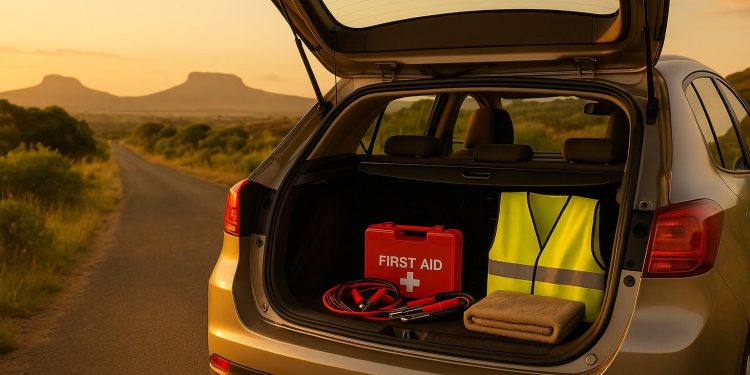Driving in South Africa can be unpredictable. From long stretches of remote highways to extreme weather conditions, being prepared is non-negotiable. A well-stocked car emergency kit can help you handle breakdowns, minor injuries, and other unexpected situations. Here’s what you need:
- First Aid Kit: Include bandages, antiseptic, medications, and tools like scissors and gloves. Consider adding a snake bite kit for remote areas.
- Visibility Tools: Reflective triangles, a flashlight, and a safety vest for staying visible during breakdowns.
- Tire and Vehicle Tools: Spare tire, repair kit, jack, jumper cables, and a portable air compressor.
- Water and Communication: At least 1 gallon of water per person, a car phone charger, and emergency contact cards.
- Basic Tools: Screwdrivers, pliers, electrical tape, and bungee cords for minor repairs.
- Special Considerations: Extra water, sunscreen, and warm clothing for long trips or extreme climates.
Regularly check and maintain your kit to ensure everything is functional and up to date. Proper preparation can make all the difference when traveling in South Africa.
Build the Ultimate Car Emergency Kit – Before You Need It
Must-Have Items for Your Car Emergency Kit
When driving in South Africa, having a well-prepared emergency kit is more than just a precaution – it’s a necessity. From handling medical situations to ensuring your visibility on the road, your kit should be equipped to tackle the unique challenges of the region. Here’s a breakdown of what you need to stay safe and prepared.
First Aid Supplies
A solid first aid kit is an absolute must, especially given South Africa’s high rate of road incidents. Start with a Regulation 3 first aid kit, which typically includes essentials like triangular bandages, conforming bandages in various sizes, and latex gloves – all packed in a compact nylon bag. To make your kit even more effective for long trips, add over-the-counter medications such as pain relievers, antihistamines, antacids, anti-nausea pills, and eye drops.
If you’re venturing into remote areas, consider specialized additions like a snake bite kit or tick removal tools. The Survival Vehicle First Aid Kit, for example, includes a SMART Snake Bandage and other snake bite emergency supplies.
"If not treated immediately, small cuts and blisters could escalate into a bad situation." – Harding Bush, Security Manager at Global Rescue
Don’t forget other key items like sterile gauze, antiseptic solution, scissors, safety pins, CPR equipment, disposable gloves, face masks, and an emergency blanket to keep you warm if needed.
Safety and Visibility Tools
Staying visible is critical when stranded on South Africa’s roads. Reflective warning triangles are a must to alert other drivers of your vehicle’s presence. Pair this with a reliable flashlight or headlamp (LED models are a great choice for their brightness and long battery life) to navigate dark conditions or inspect your car at night.
A reflective safety vest is another essential item, especially if you need to step out of your vehicle in low-light situations. Combine this with basic safety practices like activating hazard lights, using interior dome lights at night, and keeping headlights on for visibility. In areas with higher crime rates, it’s safer to stay inside your locked vehicle with the windows up.
Tire and Vehicle Maintenance Tools
Tire troubles are among the most common roadside issues, making tire repair tools indispensable. A tire repair kit with a steel-handled reamer and insertion tools can quickly fix punctures. The Desert Deluxe Tire Repair Kit, priced at about $28 (R424), is a practical option for quick repairs.
Your kit should also include a properly inflated spare tire, a jack, and a wheel brace – inspect these regularly to ensure they’re in working order. A portable air compressor can be a lifesaver for inflating tires on the go. Jumper cables are another must-have, especially for dealing with battery issues in extreme weather. Spare fuses can also come in handy for minor electrical fixes.
For more advanced repairs, the GlueTread Complete Tire Repair Kit, priced at approximately $270 (R4,065), is ideal for handling both tread and sidewall damage, making it especially useful for off-road adventures.
Water and Communication Items
Given South Africa’s climate, carrying sufficient water is non-negotiable. Aim for at least 1 gallon (about 4 liters) per person for short trips, and increase your supply for longer journeys. Distribute water across multiple containers to avoid losing your entire supply if one leaks.
Stay connected by keeping a car phone charger or a portable power bank in your kit. For extended emergencies, a solar-powered charger is a smart choice. Keep your vehicle manual in the glove compartment – it contains crucial information like fuse locations and fluid specifications. Additionally, laminate emergency contact cards with numbers for roadside assistance, insurance, and local emergency services for quick access.
Basic Tool Kit
A compact tool kit can make all the difference for minor roadside repairs. Include essentials like needle-nose pliers, flathead and Phillips screwdrivers in various sizes, electrical tape, and bungee cords to secure loose items.
Depending on your budget, you can find basic tire kits for around $4 (R59) or invest in more comprehensive kits costing up to $183 (R2,760). Tailor your selection based on your specific needs and how much you’re willing to spend.
"First-aid kits need to match the duration and location of your trip." – Harding Bush, Security Manager at Global Rescue
Special Considerations for South African Drivers
When driving in South Africa, it’s important to prepare for the unique challenges the region presents. The country’s diverse climate, long stretches between towns, and varying road conditions require a carefully tailored emergency kit. These factors make thoughtful preparation essential, and the following sections provide specific tips to address these challenges.
Hot and Dry Regions
In South Africa’s arid regions, where temperatures can soar above 100°F (38°C), staying hydrated and protected from the sun is critical. Pack extra water for each person, oral rehydration salts, and a high-SPF sunscreen. Add a wide-brimmed hat and lightweight, long-sleeved clothing to shield yourself from the harsh sun. For sunburn relief, aloe vera gel can be a lifesaver. A metallic foil blanket is another versatile item – it reflects heat during the day and provides warmth during unexpectedly chilly desert nights.
If you’re sensitive to extreme heat, consider adding cooling gear like a cooling vest or activated cooling towels. Keep these items in a sealed container to maintain their effectiveness.
Emergency Contacts and Navigation
Make sure to save these key emergency numbers: 10111 (police), 10177 (ambulance), and 112 (mobile emergencies). If you have a vehicle tracking service, such as Cartrack, their emergency lines (011 250 3000, Option 2, and 010 141 3890, Option 2) can assist with theft or hijacking incidents.
"One of the biggest challenges in any emergency is access. Access to the right emergency services, with the right skills and equipment, at the right time and at the right place. When someone experiences an emergency, they often struggle knowing who to call and where they are exactly." – Dr. Fanie Hattingh, Co-Founder of mySOS
Navigation is equally important. Keep both physical maps and downloaded offline maps in your car to handle areas with limited cell coverage. Mark key locations like fuel stations, hospitals, and police stations along your route. Apps like Google Maps, Waze, and Apple Maps are great for real-time traffic updates when you have connectivity. For added safety, explore apps with emergency assistance and GPS tracking features. You can also share your location with trusted contacts using tools like WhatsApp’s Live Location feature to ensure someone knows your whereabouts during long trips.
Preparing for Long Trips
For journeys spanning 500–1,500 kilometers, careful planning and packing are crucial. Include non-perishable snacks like energy bars and nuts, extra blankets, and warm clothing if you’ll be traveling through colder areas. Make sure your phone is fully charged and share your travel itinerary with a trusted person. If your route passes through cold zones, pack windproof and waterproof layers, as well as emergency lighting to handle unexpected situations.
Experts advise limiting driving to no more than 10 hours per day and taking breaks every 2–3 hours to avoid fatigue.
"Avoid fatigue by stopping every 2-3 hours. Don’t drive when tired, it’s as dangerous as driving under the influence." – ASI Insure
Lastly, don’t overlook comfort items like toilet paper, which can make a big difference during unexpected delays. Proper preparation ensures a safer and more pleasant journey, no matter where your travels in South Africa take you.
sbb-itb-09752ea
How to Store and Maintain Your Emergency Kit
Being prepared for emergencies in South Africa means more than just having a well-stocked kit. Proper storage and regular upkeep are key to ensuring your supplies are ready when you need them, especially given the country’s intense heat and unpredictable weather.
Storage Tips
Staying organized can save precious time during an emergency.
A sturdy trunk organizer is a great option for keeping larger emergency supplies secure and preventing them from moving around while driving. If your trunk space is tight, look into organizers that attach to the back of your seats. Some even come with built-in coolers, ideal for items sensitive to temperature changes.
South Africa’s heat can be tough on certain items. When your car is parked in the sun, interior temperatures can skyrocket, potentially damaging batteries, medications, and other sensitive supplies. To combat this, try storing items under the front seats or in the spare wheel compartment, where temperatures are generally more stable. Another tip is to place items on the floor and cover them with insulation to help keep them cool.
It’s also helpful to divide your kit into two groups: heat-sensitive and heat-resistant items. Medications, batteries, and perishables can go in an insulated container or cooler, while tools and non-perishables stay in your main kit. Filling empty spaces in your storage container with sealed water bottles can help slow temperature changes.
Finally, label all containers clearly and make sure every family member knows where the kit is stored.
Regular Maintenance and Replacement
Once your kit is stored properly, regular maintenance ensures it stays ready for use. Since most items have a shelf life, periodic inspections are a must.
Check your kit at least every six months. Replace any expired items right away. To stay on top of this, consider taping a list of expiration dates to the lid of your kit for easy reference.
During each inspection, focus on these key areas:
- Look for expired perishables and replace them.
- Test flashlights and swap out old batteries.
- Store extra batteries in the coolest spot possible and check their condition regularly.
- Ensure tools like jumper cables and tow straps are in working order.
If you use any items in an emergency, restock them as soon as possible so your kit is always complete and ready for the next situation.
Seasonal Adjustments
Adapting your kit to South Africa’s seasonal changes can make a big difference. During hot months, use a thermometer with minimum and maximum readings inside your storage container to monitor temperature fluctuations.
You can also freeze a few water bottles to rotate into your kit. This not only helps keep the contents cool but also provides fresh drinking water when needed. Adding a reflective windshield shade can further reduce your car’s interior temperature, helping to protect your supplies year-round.
Comparison Table: Key Items and Their Benefits
The table below highlights essential emergency kit items for South African roads, focusing on their practical benefits and how they address common roadside challenges. These tools and supplies are tailored to meet the unique demands of driving in South Africa, ensuring safety and preparedness.
Comparison Table Example
| Item | Function | Benefit for South African Drivers |
|---|---|---|
| Reflective Triangles | Increase visibility during breakdowns | Alerts passing drivers and enhances safety during emergencies. |
| Tire Repair Kit | Fix minor punctures and leaks | Saves time in remote areas where roadside assistance may not be readily available. |
| Water (Extra Supply) | Hydration and radiator cooling | Prevents dehydration in hot climates and helps manage engine overheating. |
| LED Flashlight/Headlamp | Provides bright light in darkness | Essential for nighttime repairs, signaling for help, and hands-free tasks. |
| Jumper Cables | Recharges a dead car battery | Prevents being stranded due to battery issues. |
| First Aid Kit | Treats injuries and medical emergencies | Addresses immediate medical needs when help is far away. |
| Portable Jump Starter | Provides a self-sufficient battery boost | Eliminates the need for another vehicle, offering reliability on isolated roads. |
| Fire Extinguisher | Suppresses vehicle fires | Enables quick action to control engine fires before they escalate. |
| Basic Tool Kit | Performs minor repairs | Allows quick fixes for common mechanical problems in remote locations. |
| Emergency Blanket | Conserves body heat | Helps regulate body temperature during overnight breakdowns. |
These items go beyond single-use purposes, offering versatile solutions for a variety of roadside challenges. For example, a high-quality LED flashlight is invaluable for nighttime repairs and emergencies, providing both brightness and durability (Future Light Team, February 2025). Similarly, carrying extra water serves a dual role: keeping you hydrated in extreme heat and cooling an overheating engine. Portable jump starters, on the other hand, are particularly useful for long and isolated highway journeys, as they provide a self-sufficient solution for battery issues.
Conclusion: Staying Safe and Prepared on South African Roads
An emergency kit is only as good as its upkeep. Even the most well-stocked kit can let you down if it’s not checked and updated regularly. That’s why routine maintenance is key.
As mentioned earlier, inspect your kit at least every six months. Replace anything that’s expired or damaged, label food and water with dates, and test your equipment to ensure it’s ready to go when you need it. Store food in airtight containers to keep it fresh and safe from spoilage. These small steps can make a big difference when emergencies arise.
Keeping your kit in good shape not only ensures you’re prepared but also saves you from unnecessary hassle and expense. In remote areas, where help might take longer to arrive, having essentials like a functioning tire repair kit or a portable jump starter can mean the difference between being stranded and getting back on the road safely.
It’s also smart to tailor your kit to the environment you’ll be traveling through. For example, pack extra water if you’re heading into arid regions or include warm clothing for colder areas.
South Africa’s roads come with their own challenges – long stretches between towns, unpredictable weather, and varying terrain. A well-maintained emergency kit can be a lifesaver in these conditions. Take the time to assemble your kit today, and make a habit of keeping it updated. It’s a simple yet powerful way to protect yourself and your passengers on the road.
FAQs
What should I pack in a car emergency kit for driving in remote areas of South Africa?
When venturing into remote areas of South Africa, being prepared with the right emergency supplies is essential for your safety. Your kit should include basics like a first aid kit, reflective warning triangles, a tire repair kit, a flashlight with extra batteries, and basic tools. Since towns can be far apart, pack plenty of water and non-perishable food to sustain you for an extended period.
Other must-haves include a portable jump starter, a fire extinguisher, blankets to keep warm, and a cell phone charger or power bank. These items are invaluable for dealing with car troubles, sudden weather shifts, or other unexpected situations, ensuring you’re prepared for the unique conditions of South African roads.
How often should I check my car emergency kit to keep it ready for use?
It’s smart to go through your car emergency kit and refresh it every six months. Look for expired items, like first aid supplies, and swap them out as necessary. Make sure tools such as flashlights have fresh batteries and confirm that everything is in proper working order.
Keeping your kit in shape means you’re ready to handle surprises – whether it’s a flat tire, sudden bad weather, or a long road trip.
How should I store and maintain a car emergency kit for South Africa’s climate?
To keep your car emergency kit in top shape, especially in South Africa’s diverse climate, make sure to store it in a cool, dry spot inside your car, away from direct sunlight. This helps prevent heat damage to essentials like water, batteries, and medical supplies.
Make it a habit to check and swap out perishable items like bottled water, snacks, and batteries every 3–6 months. This is especially important before long trips or when the seasons change. If you’re traveling in colder areas, consider adding thermal blankets and hand warmers to your kit. Using waterproof containers can also protect your supplies from rain or humidity. With regular upkeep, you’ll always be ready to handle unexpected roadside emergencies.
Related posts
- Fuel-Saving Tips for Long South African Road Trips
- 7 Winter Car Care Tips for South Africa
- 5 Romantic Coastal Drives in South Africa
- How to Prep Your Car for the December Holidays in SA





